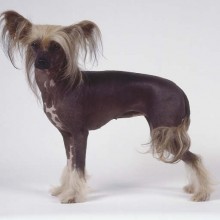Chinese Crested
Lifestyle Needs

The Chinese Crested is either the Hairless or the Powder Puff: the first only having hair on their heads, ankles and tip of tail; the second has a covering of thin, long, soft hair. The ‘Cresties’ are very small and slight and have become novelty lap dogs. Any type of home environment will suit him and his exercise requirements are modest. He is intelligent and affectionate but his fragility makes him unsuited to being a family dog. Small children should not be allowed to play with him.
Genetic Diversity
(Known as Coefficient of Inbreeding: 'COI'. It should be as low as possible.)
The UK Kennel Club breed average COI is 11.3% - See 'A Beginners Guide to COI'
Gene Pool Size
(Known as Effective Population Size: 'EPS')
81
EPS is a measure of how many individuals are contributing genetically to a breed population. It is a measure of the size of the gene pool in a breed. Lower than 100 is considered critical by conservationists and below 50 brings a breed close to extinction. For more information see the Kennel Club article.
Health and Welfare Problems due to Conformation
(Body shape and physical characteristics)
- The Chinese Crested’s very small size makes his skeletal system fragile. Broken bones are common.
- Dental problems or missing teeth
- Canine ectodermal dysplasia (hairlessness). It is unnatural for a dog to be hairless and he is susceptible to sunburn
- Suffers from the cold in winter
BVA/KC Health Schemes: www.bva.co.uk/chs
Eye Scheme
The Chinese Crested is one of the 15 high profile breeds designated by the Kennel Club as requiring particular monitoring by reason of visible conditions which may cause health and welfare concerns.
Estimated Breeding Values (EBVs) : No EBVs are currently available for this breed
www.thekennelclub.org.uk/about-ebvs
DNA Tests Available
DogWellNet and IPFD Harmonisation of Genetic Testing for Dogs (HGTD)
www.dogwellnet.com/breeds
- Progressive retinal atrophy (PRA-prcd)
- Progressive retinal atrophy (PRA-rcd3)
- Primary lens luxation (PLL)
- Ectodermal Dysplasia
- Canine multiple system degeneration (CMSD)
- Neuronal Ceroid Lipofuscinosis 7 (NCL 7)
Availability of a DNA test does not mean that it is always necessary or even desirable for breeders to use this test.
Other Breed-Specific Health Screening Schemes
None known
Ask the breeder to show you the certificates for the above tests/screening for both parents. If any of the above tests have not been considered necessary by the breeder (and there may be good reasons), ask her to explain why.
Other Diseases Reported
(For which there are currently no genetic or screening tests for sire or dam)
- Canine cutaneous histiocytoma
- Cerebellar ataxia
- Canine multiple system degeneration
- Keratoconjunctivitis sicca (‘Dry Eye’)
Ask the breeder about the medical history of the parents, grandparents and great grandparents. Consider carefully whether to purchase a puppy if some of these or other diseases are in the family line.
Ask about the breeder’s policy in cases of serious genetic diseases occurring to your puppy in later life. Good breeders will request to be informed of such events in order to improve future breeding decisions.
You are strongly advised to buy from a breeder who uses (or is prepared to use) the AWF Puppy Contract and Puppy Information Pack (PIP): www.puppycontract.org.uk
The breeder should also be familiar with the CFSG/DBRG Code of Practice for Dog Breeding